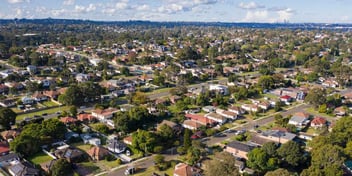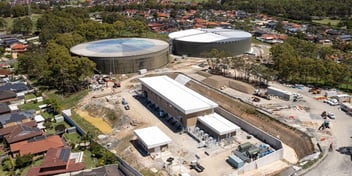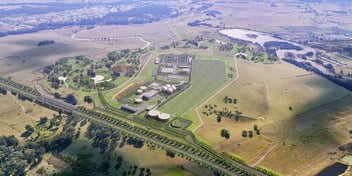Rethinking water to make for a better and more livable Western Sydney
As Australia’s largest capital continues to expand to meet the needs of a growing population, experts have been working to ensure the development of Western Sydney takes an integrative approach to land-use planning and water cycle management.
The planning for Western Sydney Parkland City had two key objectives: reduce the impact of stormwater runoff on South Creek while also rethinking water servicing in order to achieve a higher standard of community health and livability.
Sydney Water Waterways Manager Phillip Birtles said integrating urban planning with waterway management was key to meeting the significant challenges posed by environmental factors.
“The urban planning direction for Sydney includes three major centres, which are characterised by waterscapes. There’s the Eastern City including Darling Harbour, the Central City including the Parramatta River, and also the Western Parkland City involving Wianamatta-South Creek,” he said.
“The development of the Western Parkland City involves some big challenges. It doesn't get the sea breezes, it's very hot, it's very flat and it's pretty dry. As a result of this, water management is really important in terms of building a livable city.
“All these indicators point to the need for a more integrated water cycle management approach and moving into urban planning much earlier so that we are doing more than simply supplying drinking water and wastewater services.”
Birtles said the water industry is very well placed to help deliver quality environmental spaces within urban development sites.
“The water industry is in a position to deploy new approaches to stormwater, recycled water and wastewater, and consider how it all fits together in a way that will work with urban planning,” he said.
Western challenges
Sydney Water Senior Adviser Erin Saunders said Western Sydney can be up to 10 degrees hotter than other parts of the city and it’s expected that about 1.5 million additional people will be living there over the next 30 to 40 years.
“The government has a vision for the Western Parkland City to be cool, green and livable, and centred on South Creek and its tributaries as the main amenity feature. We had to look at the servicing approaches we could take as a utility provider that would contribute to those broader objectives,” she said.
“We realised through some early work that if we developed under a ‘business as usual’ scenario, 90% of the site would be impervious, which means all the rainfall would flow off into the drainage system and into surrounding waterways.
Saunders said using traditional techniques for stormwater drainage would likely place too much pressure on South Creek, which requires minimal flows for optimal health.
“The way we currently design our stormwater drainage systems is focused on draining water out of the urban environment as quickly as possible, which is why we end up with concrete channels as opposed to more naturalised drainage channels that are better aligned with the parkland vision,” she said.
“South Creek is quite unique to Sydney, it’s a very long freshwater ephemeral system. Our aim was to retain the catchment to keep those creeks in their naturalised state. During our preliminary modelling, we found the catchment creeks have very low flow parameters, and these low flows are critical to maintaining the natural hydrology.
“In order to retain the ecology and the landscape value of those waterways, the main objective has been to hold back as much storm water as we possibly could. We looked at what we could do to change the way that we design the urban environment to better hold water in the landscape.”
Protecting waterways
Saunders said one of the aims of reducing stormwater runoff was to improve the imperviousness of the site by applying some practical, proven techniques.
“Firstly, compacting the urban form by building up one story, rather than sprawling development across the site, amounts to the same yields but reduces imperviousness,” she said.
“We also used on-site stormwater storage. Rainwater tanks are pretty stock standard in residential developments. But we looked at innovative ways we could use those in non-residential development as well.
“More innovative uses include capturing stormwater and then sprinkling it back over the really large, expansive roofs of industrial warehouse buildings. This allows us to move the stormwater back into the atmosphere while contributing significantly to the cooling of those buildings.
“Another tool we’ve applied is a specific street tree design. Essentially, it's a street tree which sits in a pit connected to the stormwater drainage system. When it rains, stormwater is passively feeding the pit. It holds water below the root zone, allowing the tree to draw the water up as it's needed.
“This helps reduce stormwater levels via evapotranspiration, but also helps keep the area green and cool. Western Sydney loses a lot of trees due to heat stress.”
Saunders said performance modelling produced amazing results, both in terms of reaching stormwater runoff volume reduction targets, as well as producing a more livable urban environment.
“We were able to get three times as much tree canopy cover and we were also able to reduce maximum temperatures on an extreme heat day by about 4.5 degrees,” Saunders said.
“As we move into the future, it’s important for us to continue to think about water in new and different ways. Livable cities are about much more than pipes now, the community expects more than that.”
New opportunities
With Bligh Tanner leading the project, partnering with Architectus to provide architecture and urban planning input, one of the important aspects of the project was to reconcile a lot of the technical details while producing viable outcomes.
Bligh Tanner Project Lead and Stormwater Australia President Alan Hoban said the development of the Western Sydney Parkland City is one of the first projects of its kind.
“It’s quite unusual for a project of this nature to be led by an engineer. But what was really important for Western Sydney was to reconcile a lot of the technical details. Anywhere where there is a new greenfield development, there are set aspirations around how the development is going to be different,” Hoban said.
“But what tends to get rolled out on the ground tends to be more of the same, repeating old problems. One of the reasons for this is that the finer engineering details — garbage trucks, postal services, NBN connections — tends to bring us back to the lowest common denominator.
“The idea with this project was to take into account all of those engineering impediments at the outset, and design around them to demonstrate that these are practical solutions that could be implemented without being thwarted by technical minutiae down the track.”
The scale of the project, as well as the ability to integrate water management with urban planning from the outset, makes the Western Sydney development an invaluable opportunity for implementing new ways of designing and managing cities, Hoban said.
“I’ve been involved in quite a number of urban water projects and this is one of the most exciting ones for me. It’s a very big scale project, we are talking about building a new city the size of Adelaide, effectively. There are a lot of water management issues at play,” he said.
“By resolving these urban typologies, and providing a roadmap for how to resolve them within an urban development that still delivers target densities while also staying affordable, but ultimately creating nicer places to live, we are providing great wins for the community.
“For the urban water sector, we have come from a position of providing essential services — providing drinking water and removing wastewater — but there is a rapid opportunity emerging for the water industry to take a leading role in providing cool, green and livable cities.”
For more information on the project, access the Western Parkland City: Urban Typologies and Stormwater Solutions report here.



